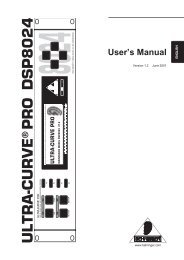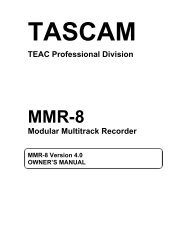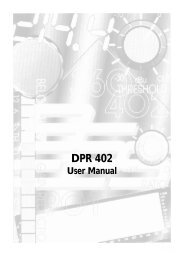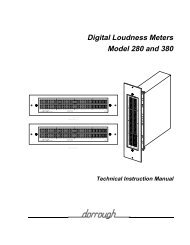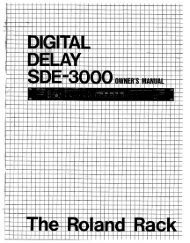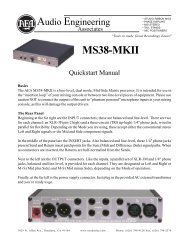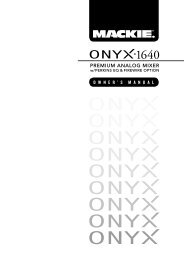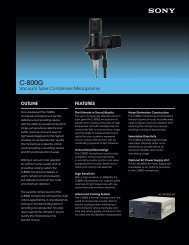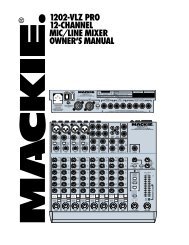XLogic SuperAnalogue Channel Owner's Manual - Solid State Logic
XLogic SuperAnalogue Channel Owner's Manual - Solid State Logic
XLogic SuperAnalogue Channel Owner's Manual - Solid State Logic
You also want an ePaper? Increase the reach of your titles
YUMPU automatically turns print PDFs into web optimized ePapers that Google loves.
Super Analogue <strong>Channel</strong><br />
Owner’s <strong>Manual</strong>
<strong>Solid</strong> <strong>State</strong> <strong>Logic</strong><br />
S U P E R A N A L O G U E<br />
C H A N N E L<br />
Super-Analogue Outboard<br />
Owner’s <strong>Manual</strong><br />
82S6XL040D
<strong>X<strong>Logic</strong></strong> <strong>Channel</strong> Owner’s <strong>Manual</strong><br />
<strong>Solid</strong> <strong>State</strong> <strong>Logic</strong><br />
Begbroke, Oxford, England, OX5 1RU • +44 (0)1865 842300<br />
320 West 46th Street, 2nd Floor, New York, NY 10036, USA • +1 (1) 212 315 1111<br />
Suite 401, 5757 Wilshire Blvd, Los Angeles, CA 90036, USA • +1 (1) 323 549 9090<br />
3-55-14 Sendagaya, Shibuya-Ku, Tokyo 151-0051, Japan • +81 (0)3 5474 1144<br />
7 bis, rue de la Victoire, le Blanc Mesnil, Paris 93150, France • +33 (0)1 48 67 84 85<br />
Via Timavo 34, 20124 Milano, Italy • +39 (0)39 2328 094<br />
Visit SSL at URL: http://www.solid-state-logic.com<br />
© <strong>Solid</strong> <strong>State</strong> <strong>Logic</strong><br />
All Rights reserved under International and Pan-American Copyright Conventions<br />
<strong>Solid</strong> <strong>State</strong> <strong>Logic</strong>, SSL and <strong>X<strong>Logic</strong></strong> are trademarks of <strong>Solid</strong> <strong>State</strong> <strong>Logic</strong><br />
All other product names and trademarks are the property of their respective owners<br />
No part of this publication may be reproduced in any form or<br />
by any means, whether mechanical or electronic, without the<br />
written permission of <strong>Solid</strong> <strong>State</strong> <strong>Logic</strong>, Oxford, England<br />
Revision 0A, September 2003<br />
Revision 0B, January 2004<br />
Revision 0C, June 2004<br />
Revision 0D, July 2004<br />
Minor changes, November 2004<br />
Minor changes, June 2005<br />
As research and development is a continual process, <strong>Solid</strong> <strong>State</strong> <strong>Logic</strong> reserves the right<br />
to change the features and specifications described herein without notice or obligation<br />
E&OE
Contents<br />
1.0 Introduction 3<br />
2.0 Safety Considerations 4<br />
Safety Warnings 4<br />
3.0 Installation 7<br />
Setting the mains voltage selector 7<br />
Mounting 7<br />
Connections 7<br />
4.0 Operation 8<br />
Input Section 8<br />
Dynamics Section 9<br />
Filter Section 10<br />
Equaliser Section 11<br />
Output Section 11<br />
5.0 Signal Routing 12<br />
Block Diagram 12<br />
Signal Routing 13<br />
Appendices:<br />
A Internal Links and Fuses 14<br />
B Connector Details 15<br />
C Electronic Specification 16<br />
D Calibration Information 21<br />
E Physical Specification 24<br />
F Environmental Specification 24<br />
Page 1
<strong>X<strong>Logic</strong></strong> <strong>Channel</strong> Owner’s <strong>Manual</strong><br />
<strong>Solid</strong><br />
<strong>State</strong><br />
<strong>Logic</strong><br />
<strong>X<strong>Logic</strong></strong> <strong>Channel</strong> (front)<br />
<strong>X<strong>Logic</strong></strong> <strong>Channel</strong> (rear)<br />
RELEASE<br />
LPF 25<br />
EXP<br />
IN<br />
24<br />
FAST<br />
HPF 30<br />
300 DYN<br />
INPUT<br />
ATT<br />
IN<br />
S/C<br />
0 40<br />
20 500<br />
18<br />
HI Z<br />
PAD 48V<br />
THRESHOLD<br />
HOLD FILTERS KHz<br />
15<br />
INPUT B - INSTRUMENT<br />
+10<br />
INPUT GAIN<br />
36 42<br />
30<br />
12<br />
6<br />
30<br />
LF<br />
GAIN LMF GAIN<br />
HMF<br />
48<br />
DYN<br />
E S/C<br />
54<br />
BELL<br />
EQ<br />
IN<br />
35 3<br />
+<br />
+<br />
RANGE<br />
Hz<br />
Hz<br />
Q<br />
KHz<br />
60 100<br />
15 220 .6 1.0<br />
B<br />
400<br />
.3 1.6<br />
40 600<br />
.2 2.0<br />
dB 72 INP<br />
60<br />
66<br />
INST<br />
Ø<br />
DYNAMICS<br />
COMPRESSOR<br />
RELEASE<br />
DYN PRE<br />
IN EQ PK<br />
1 4<br />
10 14<br />
THRESHOLD<br />
RATIO<br />
KEY LINK<br />
FAST<br />
ATT<br />
+10 -20<br />
1<br />
100V<br />
120V<br />
230V<br />
240V<br />
20<br />
GATE<br />
Q<br />
GAIN HF GAIN<br />
OUTPUT GAIN<br />
MTR<br />
BELL<br />
INPUT<br />
+<br />
+<br />
-20 +20<br />
KHz<br />
KHz<br />
XL ogic<br />
3 5 10 POWER<br />
ADC LOCK SUPER ANALOGUE<br />
C H A N N E L<br />
1 5 2 15 -24 -12 12 18 24<br />
.6<br />
1.5 22<br />
OUTPUT<br />
KEY IN<br />
DYN<br />
LINK<br />
INPUT A<br />
0<br />
1<br />
3<br />
6<br />
4<br />
0<br />
0<br />
4<br />
9<br />
4<br />
6<br />
0<br />
0<br />
2<br />
7<br />
0<br />
6<br />
Blanking plate for<br />
(optional) ADC card<br />
Page 2
Introduction<br />
1.0 Introduction<br />
The <strong>X<strong>Logic</strong></strong> <strong>Channel</strong> unit is a 1U rack mounting unit containing a complete set of signal processing from the<br />
XL 9000 channel strip – Input, Compressor/Limiter, Expander/Gate, Hi and Lo pass filters and Equaliser. An<br />
optional ADC card is available (SSL part number: 629945XT) to provide an additional digital audio output.<br />
The object of this manual is to provide purchasers of the <strong>X<strong>Logic</strong></strong> <strong>Channel</strong> unit with information in the following<br />
areas:<br />
• Safety considerations<br />
• Installation requirement<br />
• Electrical connections and cabling<br />
• Connector pin outs<br />
• Specifications and physical dimensions<br />
Warranty<br />
The warranty period for this unit is 12 months from date of purchase.<br />
In Warranty Repairs<br />
In the event of a fault during the warranty period the unit must be returned to your local distributor who will<br />
arrange for it to be shipped to <strong>Solid</strong> <strong>State</strong> <strong>Logic</strong> for repair. All units should be shipped to <strong>Solid</strong> <strong>State</strong> <strong>Logic</strong> in their<br />
original packaging. <strong>Solid</strong> <strong>State</strong> <strong>Logic</strong> can not be held responsible for any damage caused by shipping units in<br />
other packaging. In such cases <strong>Solid</strong> <strong>State</strong> <strong>Logic</strong> will return the unit in a suitable box, which you will be charged<br />
for. Please do not send manuals, power leads or any other cables - <strong>Solid</strong> <strong>State</strong> <strong>Logic</strong> can not guarantee to return<br />
them to you. Please also note that warranty returns will only be accepted as such if accompanied by a copy of<br />
the receipt or other proof of purchase.<br />
Out of Warranty Repairs<br />
In the event of a fault after the warranty period has expired, return the unit in its original packaging to your local<br />
distributor for shipment to <strong>Solid</strong> <strong>State</strong> <strong>Logic</strong>. You will be charged for the time spent on the repair (at <strong>Solid</strong> <strong>State</strong><br />
<strong>Logic</strong>'s current repair rate) plus the cost of parts and shipping.<br />
Page 3
<strong>X<strong>Logic</strong></strong> <strong>Channel</strong> Owner’s <strong>Manual</strong><br />
2.0 Safety considerations<br />
This section contains definitions and warnings, and practical information to ensure a safe working environment.<br />
Please take time to read this section before undertaking any installation work.<br />
2.1 Definitions<br />
‘Maintenance’<br />
All maintenance must be carried out by fully trained personnel. Note: it is advisable to observe suitable ESD<br />
precautions when maintenance to any part is undertaken.<br />
‘Non-User Adjustments’<br />
Adjustments or alterations to the equipment may affect the performance such that safety and/or international<br />
compliance standards may no longer be met. Any such adjustments must therefore only be carried out by fully<br />
trained personnel.<br />
‘Users’<br />
This equipment is designed for use solely by engineers and competent operators skilled in the use of professional<br />
audio equipment.<br />
‘Environment’<br />
This product is a Class A product intended to form an integrated component part of a professional audio<br />
recording, mixing, dubbing, film, TV, radio broadcast or similar studio wherein it will perform to specification<br />
providing that it is installed according to professional practice.<br />
2.2 Electrical Safety Warning<br />
When installing or servicing any item of <strong>Solid</strong> <strong>State</strong> <strong>Logic</strong> equipment with power applied, when cover<br />
panels are removed, HAZARDOUS CONDITIONS CAN EXIST.<br />
These hazards include:<br />
High voltages<br />
High energy stored in capacitors<br />
High currents available from DC power busses<br />
Hot component surfaces<br />
Any metal jewellery (watches, bracelets, neck-chains and rings) that could inadvertently come into contact<br />
with uninsulated parts should always be removed before reaching inside powered equipment.<br />
2.3 Installation<br />
Voltage Selection and Fusing<br />
All <strong>X<strong>Logic</strong></strong> units have selectable voltage inlets. Always confirm that the input mains voltage range is set correctly<br />
before applying power. Always isolate the mains supply before changing the input range setting.<br />
If it is ever necessary to replace a blown mains-fuse, then always use the correct rating and type of replacement.<br />
If a correctly rated fuse continues to blow, then a fault exists and the cause should be investigated or the unit<br />
returned to <strong>Solid</strong> <strong>State</strong> <strong>Logic</strong> for repair/replacement as appropriate.<br />
Details of mains settings and correct fuse ratings can be found in Section 3.1 and Appendix A of this manual.<br />
Safety Earth Connection<br />
Any mains powered item of <strong>Solid</strong> <strong>State</strong> <strong>Logic</strong> equipment that is supplied with a 3-core mains lead (whether<br />
connectorised or not) should always have the earth wire connected to the mains supply ground. This is the safety<br />
earth and grounds the exposed metal parts of the racks and cases and should not be removed for any reason.<br />
Page 4
Safety Considerations<br />
Mains Supply and Phases<br />
<strong>Solid</strong> <strong>State</strong> <strong>Logic</strong> equipment is designed for connection to single phase supplies with the Neutral conductor at<br />
earth potential – category TN – and is fitted with a protective fuse in the Live conductor only. It is not designed<br />
for use with Phase (Live) and Neutral connections reversed or where the Neutral conductor is not at earth<br />
potential (TT or IT supplies).<br />
Mains cables will be coded with the following colour scheme:<br />
LIVE:<br />
Brown<br />
NEUTRAL: Blue<br />
EARTH: Yellow/Green<br />
Mains Isolation and Over-Current Protection<br />
An external disconnect device is required for this equipment which must be installed according to current wiring<br />
regulations. A detachable power cord, as fitted to this equipment, is a suitable disconnect device.<br />
An external over-current protection device is required to protect the wiring to this equipment which must be<br />
installed according to the current wiring regulations. The fusing or breaking-current are defined in the product<br />
specification. In certain countries this function is supplied by use of a fused plug.<br />
CE Certification<br />
Note that the majority of cables supplied with SSL equipment are fitted with ferrite rings at each end. This is to<br />
comply with current European CE regulations and these ferrites should not be removed.<br />
If any of the unit metalwork is modified in any way this may the adversely affect the CE certification status of<br />
the product.<br />
FCC Certification<br />
The <strong>X<strong>Logic</strong></strong> unit has been tested and found to comply with the limits for a Class A digital device, pursuant to<br />
part 15 of the FCC Rules. These limits are designed to provide reasonable protection against harmful interference<br />
when the equipment is operated in a commercial environment. This equipment generates, uses, and can radiate<br />
radio frequency energy and, if not installed and used in accordance with the instruction manual, may cause<br />
harmful interference to radio communications. Operation of this equipment in a residential area is likely to cause<br />
harmful interference in which case the user will be required to correct the interference at his own expense.<br />
Page 5
<strong>X<strong>Logic</strong></strong> <strong>Channel</strong> Owner’s <strong>Manual</strong><br />
100V<br />
120V<br />
2 3 0V<br />
2 4 0V<br />
Mains Input Module<br />
100<br />
240<br />
120<br />
120<br />
100<br />
240<br />
230<br />
120<br />
230<br />
240<br />
230<br />
240<br />
100<br />
100<br />
100V Setting<br />
(Use for 90-105V)<br />
120V Setting<br />
(Use for 105-125V)<br />
230V Setting<br />
(Do not use)<br />
240V Setting<br />
(Use for 220-240V)<br />
Mains Input Programming PCB<br />
These diagrams show the PCB arrangements for the different voltage settings.<br />
Note that where the mains voltage is a nominal 230V, the ‘240V Setting’ should be used – not the ‘230V Setting’!<br />
Page 6
Installation<br />
3.0 Installation<br />
3.1 Voltage Selection<br />
Before connecting the mains supply ensure that the voltage range selector next to the IEC socket on the rear of<br />
the unit is correctly set. The input setting must be confirmed before applying power. The input module can be<br />
configured to be one of 4 voltage settings. The setting is indicated by a plastic pin protruding through the<br />
appropriate hole in the fuse panel.<br />
The setting is altered by a small vertical PCB which can be fitted in 4 positions.<br />
To change the setting:<br />
Switch off and remove the IEC lead.<br />
Using a small flat-bladed screwdriver, lever open the fuse panel to the right of the connector.<br />
At the right hand side is a vertical PCB with a plastic key which indicates the setting. Using pliers, pull<br />
out the PCB.<br />
The PCB has to be rotated until the desired voltage is shown along the edge which plugs into the module.<br />
The plastic key (and this bit is quite fiddly) must also be rotated so that it points out of the module and so<br />
that the round pin aligns with the appropriate hole in the cover panel; (refer to the diagrams opposite).<br />
Re-insert the PCB and replace the fuse panel. The plastic pin should project through the appropriate hole.<br />
3.2 Mounting<br />
The <strong>X<strong>Logic</strong></strong> unit is designed to be rack-mounted. It is 1 RU (44.5mm/1.75 inch) high. Its depth is:<br />
325 mm/12.8 inches not including heatsink.<br />
365 mm/14.3 inches including heatsink<br />
400 mm/15.75 inches including connectors<br />
Please note that the rack ears of early <strong>X<strong>Logic</strong></strong> <strong>Channel</strong> units are not capable of supporting the full weight of the<br />
unit. Therefore if the unit is to be rack-mounted, it must either be mounted on suitable rack shelves or be fitted<br />
with a pair of support brackets to reinforce the rack ears – do not rely on just the basic front panel for rack-mounting<br />
the unit. Later <strong>X<strong>Logic</strong></strong> <strong>Channel</strong> units incorporate reinforcement brackets into the chassis and so are suitable for<br />
direct rack-mounting. Should your unit require them, pairs of support brackets (SSL Part No.: 629943XR) are<br />
available from your local distributor.<br />
A 1RU space should be left above each unit to ensure adequate ventilation.<br />
3.3 Connection<br />
There are four connectors on the rear panel and a single combined XLR and mono jack on the front panel.<br />
The rear panel connections are:<br />
Input A (female XLR)<br />
Output (male XLR)<br />
Key Input (female XLR)<br />
Link Bus (TRS jack socket)<br />
The front panel connections are:<br />
Input B/Instrument (combined female XLR and mono jack)<br />
Inputs A and B are can be used for either microphone or line level signals. The HI Z switch should be selected<br />
when using line level signals as some devices may not be able to provide full output level in to the low (1.2kΩ)<br />
impedance of the standard microphone input.<br />
The mono jack provides a very high (1MΩ) impedance input, designed for use with guitar pickups, piezo electric<br />
bugs etc.<br />
Connect the output of the unit to your recorder, workstation or mixing desk. Connect the input to a suitable<br />
source. If you have more than one unit the dynamics LINK jacks on the rear of the units should be connected<br />
together using a mono or stereo jack–to–jack cable.<br />
Page 7
<strong>X<strong>Logic</strong></strong> <strong>Channel</strong> Owner’s <strong>Manual</strong><br />
4.0 Operation<br />
The <strong>X<strong>Logic</strong></strong> <strong>Channel</strong> unit is a 1U rack mounting unit containing a complete set of signal processing from the<br />
XL 9000 channel strip – Input, Compressor/Limiter, Expander/Gate, Hi and Lo pass filters and Equaliser.<br />
The signal processing order can be changed and the EQ and filter sections used in the dynamics side chain.<br />
providing a wide range of signal processing options.<br />
Obviously there are many different permutations of signal routing, allowing an enormous number of creative<br />
possibilities. This section looks at each control on the <strong>X<strong>Logic</strong></strong> <strong>Channel</strong> individually, with a brief summary of the<br />
routing possibilities. See Section 5 for more on routing.<br />
4.1 <strong>Channel</strong> Input Section<br />
The channel input can pick up any one of three inputs:<br />
INP A With the INP B and INST switches released<br />
36<br />
the input is fed by the INPUT A XLR on the rear of the<br />
30<br />
unit.<br />
INP B – Selects the female XLR on the front of the<br />
unit.<br />
INST – Selects the mono jack instrument input on the<br />
front of the unit. This is a very high impedance<br />
unbalanced input intended to be used with guitar<br />
pickups etc.<br />
24<br />
18<br />
12<br />
INPUT B - INSTRUMENT<br />
6<br />
The stepped INPUT GAIN control has a gain range of +6dB to +72dB in 6dB steps.<br />
INPUT GAIN<br />
dB 72<br />
66<br />
HI-Z – Increases the input impedance of the microphone input (inputs A or B) from 1.2kΩ to 8.45kΩ. This<br />
allows the connection of line level signals to the channel input if required, and provides an alternative<br />
input impedance for some dynamic microphones.<br />
PAD – This switch reduces the signal level by 18dB. Setting the gain to +18dB and selecting PAD sets the<br />
input gain to 0dB for use with line level signals.<br />
48V – When selected provides phantom power to the associated microphone.<br />
Please note that connecting a microphone to the <strong>X<strong>Logic</strong></strong> <strong>Channel</strong> unit with phantom power switched on is not advised<br />
as it may cause damage to either the microphone or the input stage of the <strong>X<strong>Logic</strong></strong> <strong>Channel</strong> unit. Also note that<br />
phantom power should be switched off before changing the input source to avoid possible damage to connected devices<br />
or to the input stage of the <strong>X<strong>Logic</strong></strong> <strong>Channel</strong> unit. Take care not to use phantom power when connecting line level<br />
sources (keyboards etc.) as this may damage the output stage of the connected unit.<br />
Ø (Phase) – This reverses the phase of the selected channel input.<br />
HI Z<br />
42<br />
48<br />
54<br />
60<br />
PAD<br />
INP<br />
B<br />
48V<br />
INST<br />
Ø<br />
Page 8
Operation<br />
DYNAMICS<br />
COMPRESSOR<br />
RELEASE<br />
GATE<br />
THRESHOLD<br />
HOLD<br />
DYN<br />
IN<br />
PRE<br />
EQ<br />
0<br />
PK<br />
1 4<br />
THRESHOLD<br />
3 6 10<br />
RATIO<br />
14<br />
20<br />
3<br />
0<br />
RELEASE<br />
+10<br />
0<br />
EXP<br />
RANGE<br />
0<br />
4<br />
KEY<br />
LINK<br />
FAST<br />
ATT<br />
+10 -20<br />
1<br />
1<br />
4<br />
FAST<br />
ATT<br />
0 40<br />
4.2 Dynamics Section<br />
The Dynamics section comprises a compressor/limiter and an expander/gate, both of which use the same<br />
gain change element. Both sections work independently, but can be operational at the same time,<br />
providing sophisticated control of signal levels. The Filter and/or the Equaliser section can be assigned to<br />
the dynamics side chain allowing de-essing etc.<br />
The Dynamics section has two routing buttons associated with it. Section 5 deals with Dynamics routing<br />
in more detail, but briefly these button function as follows:<br />
DYN IN – Switches the Dynamics section into the signal path pre the EQ.<br />
PRE EQ – Switches the Dynamics section pre the EQ section (but post the Filter section if the Filter INPUT<br />
switch is pressed).<br />
KEY – Switches the Dynamics side chain to the ‘KEY’ input on the rear panel of the unit.<br />
If you have more than one unit and have connected the ‘DYN LINK’ jacks on the rear of the units together<br />
the side chain control signals of multiple units can be linked by pressing the LINK switch on those units<br />
you wish to gang. When two Dynamics sections are linked, the control voltages of each section sum<br />
together, so that whichever section has the most gain reduction will control the other section.<br />
Don’t try to link two gates using the LINK button when you want the signal on one to open the other. If<br />
you need to achieve this effect, take a keying signal from one section to trigger the other. The easiest way<br />
to do this is by patching from the output of the ‘source’ channel into the Key input of the ‘destination’<br />
channel, and selecting KEY (see above) on this channel.<br />
4.3 Compressor/Limiter<br />
RATIO – When turned to 1:1, the Compressor/Limiter section is inactive. Turning the control clockwise<br />
increases the compression ratio to give a true limiter at the fully clockwise position.<br />
The compressor normally has an ‘over-easy’ characteristic. Selecting PK changes this to peak sensing, and<br />
replaces the ’over–easy’ characteristic with a hard knee, providing an alternative for some instruments.<br />
THRESHOLD – Whenever a signal exceeds the level set by this control, the compressor will start to act<br />
at the ratio set by the RATIO control. This control also provides automatic make-up gain, so as you lower<br />
the threshold and introduce more compression, the output level is increased, maintaining a steady output<br />
level regardless of the amount of compression.<br />
RELEASE – Sets the time constant (speed) with which the compressor returns to normal gain settings once<br />
the signal has passed its maximum.<br />
FAST ATT – Provides a fast attack time (3mS for 20dB gain reduction). When off the attack time is<br />
program dependent (3mS – 30mS).<br />
The yellow and red LEDs, on the bottom of the LED display area, indicate the amount of gain reduction<br />
(compression).<br />
Page 9
<strong>X<strong>Logic</strong></strong> <strong>Channel</strong> Owner’s <strong>Manual</strong><br />
DYNAMICS<br />
COMPRESSOR<br />
RELEASE<br />
GATE<br />
THRESHOLD<br />
HOLD<br />
DYN<br />
IN<br />
PRE<br />
EQ<br />
0<br />
PK<br />
1 4<br />
THRESHOLD<br />
3 6 10<br />
RATIO<br />
14<br />
20<br />
3<br />
0<br />
RELEASE<br />
+10<br />
0<br />
EXP<br />
RANGE<br />
0<br />
4<br />
KEY<br />
LINK<br />
FAST<br />
ATT<br />
+10 -20<br />
1<br />
1<br />
4<br />
FAST<br />
ATT<br />
0 40<br />
4.4 Expander/Gate<br />
This section can act as a ∞:1 Gate or as a 2:1 Expander when the EXP switch is pressed.<br />
RANGE – Determines the depth of gating or expansion. When turned fully anticlockwise (Range = 0), this<br />
section is inactive. When turned fully clockwise, a range of 40dB can be obtained.<br />
THRESHOLD – Variable hysteresis is incorporated in the threshold circuitry. For any given ‘open’ setting,<br />
the Expander/Gate will have a lower ‘close’ threshold. The hysteresis value is increased as the threshold<br />
is lowered. This is very useful in music recording as it allows instruments to decay below the open<br />
threshold before gating or expansion takes place.<br />
RELEASE – This determines the time constant (speed), variable from 0.1- 4 seconds, at which the<br />
Gate/Expander reduces the signal level once it has passed below the threshold. Note that this control<br />
interacts with the Range control.<br />
FAST ATT – Provides a fast attack time (100µs per 40db). When off, a controlled linear attack time of 1.5ms<br />
per 40dB is selected. The attack time is the time taken for the Expander/Gate to ‘recover’ once the signal<br />
level is above the threshold. When gating signals with a steep rising edge, such as drums, a slow attack<br />
may effectively mask the initial ‘THWACK’, so you should be aware of this when selecting the appropriate<br />
attack time.<br />
HOLD – Determines the time after the signal has decayed below the threshold before the gate closes.<br />
Variable from 0 to 4 seconds.<br />
The green LEDs in the display section indicate Expander/Gate activity (the amount of gain reduction).<br />
Note that when the Dynamics section is not in circuit, its sidechain input is also bypassed.<br />
4.5 Filters Section<br />
This section comprises a four–band parametric equaliser plus high and low pass filters. The EQ and filters<br />
can be routed separately to different audio paths within the module.<br />
Routing Buttons<br />
There are four routing buttons associated with this section of the<br />
module. Section 5 describes the routing combinations in more detail<br />
but, briefly, these buttons function as described below.<br />
LPF IN, HPF IN – Switches the Lo and Hi pass filter section into<br />
circuit. If no other buttons are pressed, the Filters are post the<br />
Equaliser.<br />
DYN SC – The Filters are switched into the sidechain of the Dynamics<br />
section. The Equaliser can be switched into the sidechain<br />
independently. Note that DYN SC overrides the INPUT function (see<br />
below).<br />
FILTERS<br />
INPUT – Moves the Filters to put them in circuit immediately post the <strong>Channel</strong> Input section.<br />
This allows the Filters to be used to clean up signals before compressing them. Selecting Dynamics ‘PRE<br />
EQ’ will allow the compressed signal to be EQ’d.<br />
The Filter section is completely bypassed when both Filter IN switches are not selected.<br />
HPF<br />
IN<br />
30<br />
LPF<br />
IN<br />
Hz<br />
60 100<br />
20<br />
500<br />
25<br />
300<br />
15<br />
35 3<br />
DYN<br />
S/C<br />
KHz<br />
9<br />
INPUT<br />
4<br />
Page 10
Operation<br />
LF<br />
GAIN<br />
LMF<br />
GAIN<br />
HMF<br />
GAIN<br />
HF<br />
GAIN<br />
BELL<br />
+<br />
Hz<br />
Q<br />
KHz<br />
150 220 .6 1.0<br />
+<br />
EQ<br />
IN<br />
E<br />
DYN<br />
S/C<br />
Q<br />
+<br />
2<br />
KHz<br />
BELL<br />
+<br />
KHz<br />
3 5 10<br />
60 400<br />
.3 1.6<br />
1 5<br />
2 15<br />
40 600<br />
.2 2.0<br />
.6<br />
7<br />
1.5 22<br />
4.6 Equaliser Section<br />
Routing Buttons<br />
There are three buttons associated with this section of the unit. Section 5 describes the routing<br />
combinations in more detail but, briefly, these buttons function as described below.<br />
EQ IN – Switches the EQ section into circuit.<br />
DYN SC – Switches the EQ section into the sidechain of the Dynamics section. The Filter section can be<br />
switched independently of the EQ section. If both Filter and EQ sections are assigned to the dynamic<br />
sidechain the Filter section precedes the EQ.<br />
E – Switches the EQ from ‘G’ operation to ‘E’ operation – see below.<br />
Operation<br />
This is a 4-band equaliser that can be switched between two different sets of curves, one based on SSL’s G<br />
Series EQ and the other based on the latest version of the classic E Series EQ.<br />
HF Section: Frequency range 1.5kHz – 22kHz, gain ±20dB.<br />
LF Section: Frequency range 40Hz – 600Hz, gain ±16.5dB.<br />
The HF and LF sections provide shelving equalisers with variable turnover frequency. Normally the curve<br />
has a degree of overshoot/undershoot (depending on whether you are boosting or cutting) below the<br />
selected HF frequency (or above the selected LF frequency). Selecting the ‘E’ button removes the<br />
overshoot/undershoot effect and provides a slightly gentler slope. Selecting BELL in either mode switches<br />
the equaliser to a peaking curve.<br />
HMF Section: Centre frequency 600Hz – 7kHz, gain ±20dB, continuously variable Q (0.7 – 2.5).<br />
LMF Section: Centre frequency 200Hz to 2.5kHz, gain ±20dB, continuously variable Q (0.7 – 2.5).<br />
Normally, at any Q setting, the bandwidth of the HMF and LMF sections varies with gain, whereby an<br />
increase in boost or cut increases the selectivity of the EQ. This type of EQ can sound effective when used<br />
at moderate settings; the gentle Q curve lends itself to the application of overall EQ on combined sources<br />
and subtle corrective adjustments to instruments and vocals.<br />
When the EQ is switched to ‘E’ operation, the bandwidth of the HMF and LMF sections remains constant<br />
at all gains, so at lower gains the EQ curves are comparatively narrower for a given Q setting. This is<br />
particularly useful for drums, since relatively high Q is available at low gain settings. However, it is not<br />
so suitable for overall EQ or subtle corrections, as you need to adjust the Q to maintain the same effect<br />
when the gain is changed.<br />
4.7 Output Section<br />
The Output section consists of a ±20dB output gain control, indented at<br />
centre and a 7-segment LED meter. Normally the meter reads the output of<br />
the channel, but selecting MTR INPUT will meter the signal immediately<br />
post the input section.<br />
The blue POWER LED indicates that the unit is powered (what else).<br />
The ADC LOCK LED indicates that the (optional) ADC card is locked to an<br />
external clock.<br />
OUTPUT<br />
MTR<br />
INPUT<br />
-20<br />
GAIN<br />
+20<br />
POWER<br />
ADC LOCK<br />
-24 -12 0 6 12 18 24<br />
Page 11
<strong>X<strong>Logic</strong></strong> <strong>Channel</strong> Owner’s <strong>Manual</strong><br />
<strong>X<strong>Logic</strong></strong> <strong>Channel</strong> Block Diagram<br />
INPUT A<br />
INPUT B<br />
INSTRUMENT<br />
INST<br />
INP<br />
B<br />
+48V<br />
PHANTOM<br />
POWER<br />
+48V<br />
HI Z<br />
INPUT GAIN<br />
+6 — +72dB<br />
KEY INPUT<br />
Ø<br />
F DYN<br />
S/C<br />
KEY<br />
INPUT<br />
PRE<br />
EQ<br />
EQ F<br />
DYN<br />
SCH<br />
DYN<br />
SCH<br />
EQ F<br />
DYN<br />
S/C<br />
MTR<br />
INPUT<br />
LINK<br />
-24 -12 0 6 12 18 24<br />
OUTPUT GAIN<br />
±20dB<br />
OUTPUT<br />
DYN LINK<br />
Stereo Jack<br />
Page 12
Signal Routing<br />
5.0 Signal Routing<br />
<strong>Channel</strong> Processing Order<br />
There are two switches that control the order of the signal processing elements. These are Filters to INPUT and<br />
Dynamics PRE EQ. The table below shows the effect of these:<br />
Switch 1 Switch 2<br />
Processing Order<br />
Filters to<br />
'INPUT'<br />
Dynamics<br />
'PRE EQ'<br />
Filters to<br />
'INPUT'<br />
Dynamics<br />
'PRE EQ'<br />
Equaliser Filters Dynamics<br />
Filters Equaliser Dynamics<br />
Dynamics Equaliser Filters<br />
Filters Dynamics Equaliser<br />
Side Chain Processing Order (KEY switch released)<br />
The EQ and filter sections can be assigned to the dynamics side chain using the DYN S/CH switches in the<br />
respective sections. The table below shows the sidechain source and processing for the various combinations of<br />
these:<br />
Switch 1 Switch 2<br />
EQ to<br />
'DYN S/C '<br />
Filters to<br />
'DYN S/C '<br />
EQ to<br />
'DYN S/C '<br />
Filters to<br />
'DYN S/C '<br />
Side chain<br />
source<br />
Dynamics<br />
Input<br />
Dynamics<br />
Input<br />
Dynamics<br />
Input<br />
Dynamics<br />
Input<br />
Side chain processing order<br />
Equaliser<br />
Filters<br />
Equaliser Filters<br />
Side Chain Processing Order (KEY switch in)<br />
Finally the side chain can be fed from the KEY input on the rear of the unit by selecting KEY. The table below<br />
shows the sidechain source and processing for the various combinations of DYN S/CH switches:<br />
Switch 1 Switch 2<br />
Side chain processing order<br />
EQ to<br />
'DYN S/C '<br />
Filters to<br />
'DYN S/C '<br />
EQ to<br />
'DYN S/C '<br />
Filters to<br />
'DYN S/C '<br />
KEY Input<br />
KEY Input Equaliser<br />
KEY Input Filters<br />
KEY Input Equaliser Filters<br />
Page 13
<strong>X<strong>Logic</strong></strong> <strong>Channel</strong> Owner’s <strong>Manual</strong><br />
Appendix A – Internal Links and Fuses<br />
Fuses (Mains Inlet)<br />
The mains inlet contains a single 1 amp 1.25" time delay fuse (SSL Part No. 35FJJ310). To change it disconnect the<br />
mains inlet, then using a small screwdriver prise open the mains selector cover. This contains the fuse. Test and<br />
replace with the same type and value if necessary.<br />
Internal Fuses<br />
The internal power rails are also individually fused. These fuses should only be changed by suitably experienced<br />
staff. They are listed below:<br />
Fuses (629610X2 Power Regulator Card)<br />
+48V FS1 - 500mA wire ended (SSL part No. 35F5E250)<br />
Fuses (629601X1 Main Card)<br />
–18V FS1 - 3 amp wire ended (SSL part No. 35F5E330)<br />
–15V FS2 - 3 amp wire ended (SSL part No. 35F5E330)<br />
+15V FS3 - 3 amp wire ended (SSL part No. 35F5E330)<br />
+18V FS4 - 3 amp wire ended (SSL part No. 35F5E330)<br />
+5V FS5 - 3 amp wire ended (SSL part No. 35F5E330)<br />
Links<br />
LK1 Solder link. Links digital and analogue 0V. Do not remove.<br />
LK2 Links chassis and analogue 0V. Normally fitted. Remove to increase impedance to 10Ω.<br />
Page 14
Appendix<br />
Appendix B – Connector Details<br />
All XLR Inputs and Outputs<br />
Location: Front and Rear Panels<br />
Conn' Type: XLR Female<br />
Pin Description<br />
1 Chassis<br />
2 Audio +ve<br />
3 Audio -ve<br />
Instrument Input<br />
Location:<br />
Conn' Type:<br />
Pin<br />
Tip<br />
Sleeve<br />
Front Panel<br />
Mono 1/4" Jack Socket<br />
Description<br />
Guitar Input<br />
Chassis<br />
Dynamics Link<br />
Location:<br />
Conn' Type:<br />
Pin<br />
Tip<br />
Ring<br />
Sleeve<br />
Rear Panel<br />
Stereo 1/4" Jack Socket<br />
Description<br />
Link Bus*<br />
Link Bus*<br />
0V<br />
*Note that tip and ring are linked to allow use of<br />
mono jacks<br />
Page 15
<strong>X<strong>Logic</strong></strong> <strong>Channel</strong> Owner’s <strong>Manual</strong><br />
Appendix C – Performance Specification<br />
The following pages contain audio performance specification figures for the <strong>X<strong>Logic</strong></strong> <strong>Channel</strong> unit. No other <strong>Solid</strong><br />
<strong>State</strong> <strong>Logic</strong> products are covered by this document and the performance of other <strong>Solid</strong> <strong>State</strong> <strong>Logic</strong> products can<br />
not be inferred from the data contained herein.<br />
Measurement Conditions<br />
For each set of figures on the following pages, the specific unit and test setup will be stated at the beginning of<br />
that section. Any changes to the specified setup for any particular figure(s) will be detailed beside the figures to<br />
which that difference applies.<br />
Measurement References<br />
Unless otherwise specified the references used in this specification are as follows:<br />
• Reference frequency:<br />
1kHz<br />
• Reference level:<br />
0dBu, where 0dBu ≈ 0.775V into any load<br />
• Source impedance of Test Set: 50Ω<br />
• Input impedance of Test Set: 100kΩ<br />
• All unweighted measurements are specified as 22Hz to 22kHz band limited RMS and are expressed in<br />
units of dBu<br />
• All distortion measurements are specified with a 36dB/Octave low pass filter at 80kHz and are expressed<br />
as a percentage<br />
• The onset of clipping (for headroom measurements) should be taken as 1% THD<br />
• Unless otherwise quoted all figures have a tolerance of ±0.5dB or 5%<br />
<strong>Channel</strong> Microphone Amplifier<br />
Measurement Conditions<br />
Signal applied to <strong>Channel</strong> Microphone Input (A or B) and measured at Output. Pad switched out and Input Gain<br />
control set to +6dB.<br />
Gain<br />
Variable from +6dB to +72dB in 6dB steps<br />
Independently switchable 18dB Pad available<br />
Input Impedance<br />
> 1.5kΩ (or 8.45kΩ with HI Z ‘IN’)<br />
Output Headroom<br />
> +26dBu at onset of clipping<br />
THD + Noise<br />
< 0.003% at 1kHz<br />
(-10dBu applied, +30dB gain) < 0.005% at 10kHz<br />
Frequency Response<br />
+0.05dB/-0.1dB from 20Hz to 20kHz<br />
–3dB at 200kHz<br />
Equivalent Input Noise < –127dBu at maximum gain (input terminated with 150Ω)<br />
< –90dBu at 0dB gain (+18dB with Pad ‘IN’)<br />
Common Mode Rejection > 75dB from 50Hz to 1kHz<br />
(-10dBu applied, +30dB gain) > 70dB at 10kHz<br />
Page 16
Appendix<br />
<strong>Channel</strong> Instrument Input<br />
Signal applied to <strong>Channel</strong> Instrument Input and measured at Output. Pad switched out and Input Gain control<br />
set to +6dB.<br />
Gain<br />
Variable from +6dB to +72dB in 6dB steps<br />
Independently switchable 18dB Pad<br />
Input Impedance<br />
1MΩ<br />
Output Headroom<br />
> +26dBu at onset of clipping<br />
THD + Noise<br />
< 0.003% at 1kHz<br />
(-10dBu applied, +30dB gain) < 0.005% at 10kHz<br />
Frequency Response<br />
+0.05dB/-0.1dB from 20Hz to 20kHz<br />
–3dB at 200kHz<br />
Equivalent Input Noise < –70dBu at +40dB gain<br />
(Input terminated with 150Ω) < –89dBu at +20dB gain<br />
<strong>Channel</strong> Output<br />
Output is fully balanced and floating, and incorporates SSL’s cable compensating output design, allowing it to<br />
drive long cable runs without degrading the frequency response.<br />
Gain<br />
Continuously variable from -20dB to +20dB with indent at 0dB position<br />
Output Impedance:<br />
< 40Ω<br />
Page 17
<strong>X<strong>Logic</strong></strong> <strong>Channel</strong> Owner’s <strong>Manual</strong><br />
<strong>Channel</strong> Equaliser<br />
Each channel contains a four band equaliser that can be switched between two different sets of curves, one based<br />
on SSL’s G Series EQ and the other based on the latest version of the classic E Series EQ. High and low pass filters<br />
are also available.<br />
The LF and HF bands have variable turnover frequency with switchable bell/shelving and selectable response<br />
curves (see the upper plot, opposite):<br />
• Normal (‘G type’) curves with the ‘E’ switch OUT, have a modified slope with a degree of<br />
overshoot/undershoot for increased selectivity<br />
• ‘E type’ curves with the ‘E’ switch IN follow conventional cut or boost characteristics<br />
The two parametric bands have selectable characteristics which affect the relationship between frequency<br />
bandwidth and gain (see the lower plot, opposite):<br />
• With the ‘E’ switch OUT, the frequency bandwidth reduces with increased gain, thereby increasing the<br />
selectivity of the EQ as the gain is increased<br />
• With the ‘E’ switch IN, the frequency bandwidth is constant at all gains<br />
• At full boost or cut both are identical<br />
HF Band controls:<br />
Frequency<br />
Gain<br />
‘Q’<br />
HMF Band controls:<br />
Frequency<br />
Gain<br />
‘Q’<br />
LMF Band controls:<br />
Frequency<br />
Gain<br />
‘Q’<br />
LF Band controls:<br />
Frequency<br />
Gain<br />
‘Q’<br />
Filter controls:<br />
Low Pass<br />
High Pass<br />
Variable from 1.5kHz to 22kHz<br />
Variable between ±20dB<br />
2.5 (on ‘BELL’ setting)<br />
Variable from 600Hz to 7kHz<br />
Variable by > ±20dB<br />
Variable from 0.5 to 2.5 (may also vary with gain)<br />
Variable from 200Hz to 2.5kHz<br />
Variable by > ±20dB<br />
Variable from 0.5 to 2.5 (may also vary with gain)<br />
Variable from 40Hz to 600Hz<br />
Variable between ±16.5dB<br />
2.5 (on ‘BELL’ setting)<br />
3kHz to 50kHz (–3dB Point) @ 12dB/Octave<br />
20Hz to 500Hz (–3dB Point) @ 18dB/Octave<br />
Measurement Conditions<br />
Signal applied to Input A and measured at Output. EQ switched In. All EQ controls set centre as appropriate.<br />
THD + N<br />
< 0.005% at +20dBu 1kHz<br />
< 0.007% at +20dBu 10kHz<br />
Frequency Response<br />
±0.1dB from 20Hz to 20kHz<br />
–3dB at 200kHz<br />
Output Headroom<br />
> +26dBu at onset of clipping<br />
Noise<br />
< –86dBu<br />
Page 18
Appendix<br />
25.0<br />
20.0<br />
15.0<br />
<strong>Channel</strong> Equaliser Curves<br />
'E type'<br />
'G type"<br />
Amplitude (dBr) v Frequency (Hz)<br />
10.0<br />
5.0<br />
0.0<br />
-5.0<br />
-10.0<br />
-15.0<br />
-20.0<br />
-25.0<br />
20 100 1k 10k 100k<br />
25.0<br />
20.0<br />
15.0<br />
10.0<br />
5.0<br />
<strong>Channel</strong> Equaliser Curves<br />
'E type'<br />
'G type'<br />
Both<br />
Amplitude (dBr) v Frequency (Hz)<br />
0.0<br />
-5.0<br />
-10.0<br />
-15.0<br />
-20.0<br />
-25.0<br />
10 100 1k 10k 20k<br />
Page 19
<strong>X<strong>Logic</strong></strong> <strong>Channel</strong> Owner’s <strong>Manual</strong><br />
<strong>Channel</strong> Dynamics<br />
Each channel contains a complete dynamics section, the functions of which split into two areas;<br />
a Compressor/Limiter and an Expander/Gate.<br />
Compressor/Limiter<br />
Controls:<br />
Ratio (slope)<br />
Variable from 1 to infinity (limit)<br />
Threshold<br />
Variable from +10dB to –30dB<br />
Attack Time<br />
Normally auto sensing, switchable to 1mSec<br />
Release<br />
Variable from 0.1 to 4 seconds<br />
The <strong>X<strong>Logic</strong></strong> <strong>Channel</strong> unit Compressor/Limiter has two modes of signal detection, Peak and RMS. As their names<br />
suggest these modes of detection either act on peaks of the incoming signals or on their RMS levels. This gives<br />
two very different modes of compression and limiting with Peak Mode giving far more dramatic compression<br />
characteristics.<br />
Expander/Gate<br />
Controls:<br />
Range<br />
Variable from 0 to 40dB<br />
Threshold<br />
Variable from –30dB to +10dB<br />
Attack Time Normally auto-sensing, switchable to 150µs<br />
Hold Time<br />
Variable from 0 to 4 seconds<br />
Release Time<br />
Variable from 0.1 to 4 seconds<br />
The side chain signal can be sourced either from the signal feeding the dynamic or the external Key input. Filters<br />
and/or Equaliser can be inserted in the sidechain.<br />
LED meters independently indicate amount of compression and expansion.<br />
Measurement Conditions<br />
Signal applied to Input A, output measured at <strong>Channel</strong> Output. All pots anti-clockwise and switches ‘out’ except<br />
for Dynamics ‘in’.<br />
THD + N (+10dBu applied) < 0.01% at 1kHz<br />
Signal at +14dBu applied to Input A, input gain set to +6dB, Compressor Threshold set at –20, Compressor Ratio<br />
adjusted to give +4dBu at Output. RMS sensing mode selected.<br />
THD + N<br />
< 0.3% at 1kHz<br />
(Fast Attack Mode) † < 0.05% at 10kHz<br />
THD + N<br />
< 0.03% at 1kHz<br />
(Slow Attack Mode)<br />
< 0.05% at 10kHz<br />
† LF distortion is consistent with attack and release time constants.<br />
Output Headroom<br />
Frequency Response<br />
Noise<br />
> +26dBu at onset of clipping<br />
±0.2dB from 20Hz to 20kHz<br />
–3dB at 130kHz<br />
< –86dBu<br />
Page 20
Appendix<br />
Appendix D – Calibration Information<br />
The <strong>X<strong>Logic</strong></strong> <strong>Channel</strong> unit is factory calibrated and should only need calibration if a potentiometer or other<br />
component has been replaced or if it is suspected that there is a problem with calibration.<br />
In all of the following instructions it is assumed that the lid has been removed and that power has been applied.<br />
It is also assumed that unless otherwise specified, all switches are released and all potentiometers are at unity,<br />
minimum or indent position as appropriate. The required accuracy for each adjustment will be specified along<br />
with the target value.<br />
All level and distortion measurements should be made with audio-band 20Hz to 20kHz filters unless otherwise<br />
specified.<br />
Microphone Input<br />
Equipment Required:<br />
Test Signal:<br />
Input and Output:<br />
Unit Setup:<br />
CMRR Trim<br />
Adjustment:<br />
Output Stage<br />
Equipment Required:<br />
Test Signal:<br />
Input and Output:<br />
Unit Setup:<br />
Unity Gain Trim<br />
Adjustment:<br />
Meter Calibration<br />
Equipment Required:<br />
Test Signal:<br />
Input and Output:<br />
Unit Setup:<br />
Adjustment:<br />
Calibrated audio oscillator and audio level meter<br />
50Hz sinewave @ –12dBu, common mode<br />
Oscillator to Input A (or B) and Output to the audio level meter<br />
Set the Input Gain to ‘36dB’ and the Output Gain to indent (0dB)<br />
On the 629602 card, adjust VR22 for minimum level (normally < –40dBu)<br />
Calibrated audio oscillator and audio level meter<br />
1kHz sinewave @ –6dBu<br />
Oscillator to Input A (or B) and Output to the audio level meter<br />
1. Set the Input Gain to ‘6dB’ and the Output Gain to indent (0dB).<br />
2. Press HI-Z switch IN.<br />
On the 629603 (upper) card, adjust VR29 for 0dBu ±0.05dB<br />
Calibrated audio oscillator and audio level meter<br />
1kHz sinewave @ –6dBu<br />
Oscillator to Input A (or B) and Output to the audio level meter<br />
1. Set the Input Gain to ‘6dB’ and the Output Gain to indent (0dB).<br />
2. Check for +24dBu output level.<br />
1. On the 629602 card, adjust VR26 (METER 0dB) until the ‘+24’ meter LED is just<br />
illuminated.<br />
2. Reduce oscillator level to +18dBu, then +12dBu etc. and check that the correct<br />
meter LEDs light. At each point, reduce the level slightly using the Output Gain<br />
control and check each LED extinguishes.<br />
Page 21
<strong>X<strong>Logic</strong></strong> <strong>Channel</strong> Owner’s <strong>Manual</strong><br />
EQ Alignments<br />
Equipment Required:<br />
Test Signal:<br />
Input and Output:<br />
Unit Setup:<br />
Gain at Indent<br />
Adjustment<br />
HF EQ - Maximum Gain<br />
Adjustment:<br />
HMF EQ - Maximum Gain<br />
Adjustment:<br />
LMF EQ - Maximum Gain<br />
Adjustment:<br />
LF EQ - Maximum Gain<br />
Adjustment:<br />
Calibrated audio oscillator and audio level meter<br />
Sinewave @ -6dBu, frequencies as specified below<br />
Oscillator to Input A (or B) and Output to the audio level meter<br />
1. Set the Input Gain to +6dB and the output gain to the indent. Press HI-Z switch<br />
IN. Check that the Filters and Dynamics are switched out.<br />
2. Switch the EQ in and release all other EQ switches.<br />
3. Set all of the Q and Frequency controls fully anti-clockwise and all EQ gain<br />
controls to their centre indent.<br />
1. Measure the audio level with a probe. On the upper card (629603), measure the<br />
following test points and adjust as required:<br />
a. Probe TP1 and adjust VR22 for a minimum.<br />
b. Probe TP2 and adjust VR23 for a minimum.<br />
c. Probe TP3 and adjust VR25 for a minimum.<br />
d. Probe TP4 and adjust VR28 for a minimum.<br />
e. Probe TP5 and adjust VR27 for a minimum.<br />
2. Check the audio level meter for 0dBu ±0.01dB (adjust the audio oscillator if<br />
necessary).<br />
1. Set HF Gain to maximum and select HF BELL. Set the audio oscillator for 12kHz<br />
and adjust HF Frequency to find the maximum level on the audio level meter.<br />
2. On the 629603 (upper) card adjust VR26 for +20dBu ±0.25dB.<br />
3. Reset HF Gain to its centre indent position, de-select HF BELL and re-check the<br />
audio level meter for 0dBu.<br />
1. Set HMF Gain to maximum and HMF Q fully anti-clockwise. Set the audio<br />
oscillator for 3kHz and adjust HMF Frequency to find the maximum level on the<br />
audio level meter.<br />
2. Adjust VR30 on the 629602 card for +21dBu ±0.25dB.<br />
3. Reset HMF Gain to its centre indent position, re-check the audio level meter for<br />
0dBu.<br />
1. Set LMF Gain to maximum and LMF Q fully anti-clockwise. Set the audio<br />
oscillator for 1kHz and adjust LMF Frequency to find the maximum level on the<br />
audio level meter.<br />
2. Adjust VR29 on the 629602 card for +21dBu ±0.25dB.<br />
3. Reset LMF Gain to its centre indent position, re-check the audio level meter for<br />
0dBu.<br />
1. Set LF Gain to maximum and select LF BELL. Set the audio oscillator for 80Hz<br />
and adjust LF Frequency to find the maximum level on the audio level meter.<br />
2. On the 629603 (upper) card adjust VR24 for +16.5dBu ±0.25dB.<br />
3. Reset LF Gain to its centre indent position, de-select LF BELL and re-check the<br />
audio level meter for 0dBu.<br />
Page 22
Appendix<br />
Dynamics Adjustments<br />
If the dynamics circuitry requires adjustment the following procedure should be followed in the order shown, in<br />
its entirety. All presets are on the 629602 card.<br />
Equipment Required: Calibrated audio oscillator, audio distortion analyser, audio level meter,<br />
oscilloscope and a (digital) DC volt meter<br />
Test Signal:<br />
1kHz sinewave unless specified otherwise, level as specified<br />
Input and Output:<br />
Oscillator to Input A (or B), Output to either the distortion analyser or the level<br />
meter, as specified below. Use the oscilloscope to monitor the measured signal.<br />
Unit Setup:<br />
Switch the dynamics IN and the EQ and Filter sections OUT, set all of the<br />
dynamics controls anti-clockwise and release all switches<br />
Distortion<br />
Adjustment:<br />
1. Connect the distortion analyser to the Output and set the oscillator level for<br />
+20dBu.<br />
2. Adjust VR24 for minimum distortion (< 0.02%).<br />
Control Voltage Feedthrough<br />
Adjustment:<br />
1. Set the oscillator for 60Hz at –12.5dBu and connect the level meter to the Output.<br />
2. Connect oscillator +ve to test point TP3 and oscillator –ve to test point TP6 (0VA)<br />
using clip probes and a suitable lead.<br />
3. Adjust the offset trim VR23 to null the control voltage feedthrough seen at the<br />
output, typically less than –65dBu.<br />
Sidechain Offset<br />
Adjustment:<br />
Compressor Threshold<br />
Adjustment:<br />
Gate Threshold<br />
Adjustment:<br />
1. Connect the level meter to the Output and set the oscillator level for –28dBu.<br />
2. Turn preset VR28 fully anti-clockwise.<br />
3. Measure the DC voltage at test point TP4 relative to 0VA (use TP6) and adjust<br />
VR25 for 0V ±10mV.<br />
1. Set the oscillator level for +14dBu.<br />
2. Connect the level meter to the Output. Check for +20dBu ±0.5dB.<br />
3. Set the compressor ratio control fully clockwise and release the compressor<br />
FST ATT and PK switches.<br />
4. Adjust VR28 for a gain reduction of 4dB.<br />
5. Press the FST ATT switch in and check for a gain reduction of 8.5dB ±0.25dB.<br />
6. Reset the compressor ratio control fully anti-clockwise.<br />
1. Set the oscillator level for +4dBu and connect the level meter to the Output.<br />
2. Set the gate/expander to ‘gate’ by releasing the EXP switch, set the gate range<br />
and gate threshold controls fully clockwise.<br />
3. Adjust VR27 so that the gate just switches on.<br />
4. Check this adjustment by changing the oscillator level a little. Re-adjust VR27 if<br />
necessary so that the gate just opens when a +10dBu signal @ 1kHz is applied.<br />
Page 23
<strong>X<strong>Logic</strong></strong> <strong>Channel</strong> Owner’s <strong>Manual</strong><br />
Appendix E – Physical Specification *<br />
Depth:<br />
325mm/12.8 inches not including heatsink<br />
365mm/14.3 inches including heatsink<br />
400mm/15.75 inches including connectors<br />
Height:<br />
44.5mm/1.75 inches (1 RU)<br />
Width:<br />
480mm/19 inches<br />
Weight:<br />
4.1kg/9 pounds<br />
Power:<br />
22 Watts/30 VA<br />
Boxed size: 520mm x 520mm x 182mm (20.5" x 20.5" x 7.2")<br />
Boxed weight:<br />
6.4kg (14 pounds)<br />
* All weights and dimensions are approximate<br />
Appendix F – Environmental Specification<br />
Temperature Operating: 5 to 30 Deg. C<br />
Non-operating:<br />
–20 to 50 Deg. C<br />
Max. Gradient:<br />
15 Deg. C/Hour<br />
Relative Humidity Operating: 20 to 80 %<br />
Non-operating: 5 to 90 %<br />
Max. wet bulb:<br />
29 Deg. C (non-condensing)<br />
Vibration Operating: < 0.2 G (3 - 100Hz.)<br />
Non-operating, power off: < 0.4 G (3 - 100Hz.)<br />
Shock Operating: < 2 G (10mSec. Max.)<br />
Non-operating:<br />
< 10 G (10mSec. Max.)<br />
Altitude Operating: 0 to 3000m (above sea level)<br />
Non-operating:<br />
0 to 12000m<br />
Page 24
Appendix<br />
Notes<br />
Page 25
<strong>X<strong>Logic</strong></strong> <strong>Channel</strong> Owner’s <strong>Manual</strong><br />
Page 26



